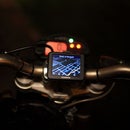Introduction: Dragon Bowl: Inverted Watermelon
For a long long time people have created functional containers from fruit/vegetable skins. I aimed to do the same from the skin of a watermelon instead of being discarded or composted.
This is a product made through the experimentation with different materials and processes, which is always interesting and provides a large amount of challenges for me. Check out my other Instructable projects, and website if you are intrigued.
Things you will need:
+ A watermelon or part thereof
+ A spoon
+ A craft knife
+ A small bowl for shaping
+ (ideally) warm dry air
+ some patience.
Optional: Oven, hair dryer, rice, plastic container.
Step 1: Empty the Watermelon
The first step is to eat the majority of the watermelon pulp. Don’t cut the watermelon into slices, but rather scoop out using a pudding spoon.
The watermelon I used was pretty much spherical, and what you see in the images is half of the melon.
When you’re done with most of the pulp, you will need to scrape away the majority of the pink flesh leaving approximately 8mm of the more ridged white flesh. Eat all the scraped out pulp and slurp the last of the watermelon nectar (waste not want not).
Step 2: Cutting the Grooves
The next step is to cut grooves into the outside of the watermelon.
The reason for these cuts are twofold: 1 to allow for moisture to escape through the gaps created on the waxy water retentive outer layer, and 2 To allow for the water melon to be folded inside-out.
The interesting aesthetic created by the cuts is a further benefit (however not functional).
The method I created the cuts was to first cut into the skin normal/perpendicular to the edge, approximately 2mm into the surface. Once I completed the network of cuts, I then cut at approximately 45 degrees to the initial cut, allowing for the thin slithers of skin to be removed.
Step 3: Drying Process
There is a large amount of water in the watermelon (obvious) which made for a tricky journey of attempting every drying process I had at my disposal.
1. First I dabbed off most of the moisture with dishtowels.
2. I tried to dry it as quick as possible, which would prevent any mould or rotting to perish the skin.
3. I tried a hair dryer for a while but got bored.
4. I preheated my microwave grill for a while and checked how well that would work.
5. I tried covering it with rice.
6. I left it outside in the sun for a day.
7. A 60w directional spot bulb in close proximity proved the most effective method of removing the moisture.
If the weather was better, I would have had the patience to rely solely on sun-drying, but alas.
The thickness of the skin soon decreased from the 8mm, down to approximately half. The rigidity of the watermelon also soon disappeared, forming a flexible malleable form.
Step 4: Flip It
Turn the watermelon inside out.
The flexible form is now able to be ‘flopped’ inside out, and draped over a form. I used a small enamel bowl, which was a perfect size.
I did not plan for it to fit this particular bowl, but rather had a look through the kitchen cupboard to find a suitable bowl.
The bowl is then left near the heat source to allow for more of the moisture to be leave the skin. You can see a glass weight which was placed on the inverted watermelon. This helped create a flat spot on what would later become the underside of the bowl.
Step 5: Use It
As more moisture leaves the skin, it slowly stiffens and becomes a ridged solid form.
When the bowl is completely dry, the interesting patterns created on what once was the outside of the watermelon now resemble olive green reptile scales. The inside of the bowl has a hard, naturally waxy finish which works rather well as the exposed interior surface.
Although this is not dish-washer/hand-wash safe, it makes for an interesting usable object encouraging the clever implementation/use of what many would otherwise be considered waste.

Participated in the
Instructables Green Design Contest













